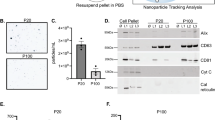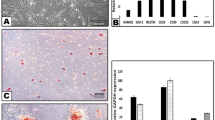Abstract
THE structures of five neurotrophic molecules have so far been published. Nerve growth factor1, fibroblast growth factor2, 3 and purpurin4, have been identified as nerve-cell survival molecules. More recently, brain-derived neurotrophic factor (BDNF) and ciliary neurotrophic factor have been cloned and sequenced5, 6. As all these proteins stimulate the survival of ciliary or sensory neurons, a new cell survival assay is required if novel neurotrophic molecules are to be discovered. P19 teratoma cells differentiate to nerve-like cells in the presence of 5 x 107 M retinoic acid (RA)7, 8. But when P19 cells are plated in N2 synthetic medium9 without being exposed to RA, they die within 48 h. In an attempt to identify a molecule(s) that can substitute for RA in promoting P19 survival, we assayed serum-free growth-conditioned media for their ability to promote P19 survival. One cell line from the rat eye secreted a molecule that promoted the survival of P19 cells and some types of nerve cell. We identified this molecule as activin, better known for its role in hormone secretion.
This is a preview of subscription content, access via your institution
Access options
Subscribe to this journal
Receive 51 print issues and online access
$199.00 per year
only $3.90 per issue
Buy this article
- Purchase on Springer Link
- Instant access to full article PDF
Prices may be subject to local taxes which are calculated during checkout
Similar content being viewed by others
References
Levi-Montalcini, R. Prog. Brain Res. 45, 235–258 (1976).
Baird, A. & Bohlen, P. in Peptide Growth Factors and their Receptors (eds Sporn, M. B. & Roberts, A.) 197–225 (Springer-Verlag, Heidelberg) (1990).
Schubert, D., Ling, N. & Baird, A. J. Cell Biol. 104, 635–643 (1987).
Berman, P. et al. Cell 51, 135–142 (1987).
Lin, L. F. et al. Science 246, 1023–1025 (1989).
Leibrock, J. et al. Nature 341, 149–151 (1989).
Edwards, M. K. & McBurney, M. W. Devl Biol. 98, 189–191 (1983).
Levine, J. M. & Flynn, P. J. Neurosci. 6, 3374–3381 (1986).
Bottenstein, J. & Sato, G. Proc. natn. Acad. Sci. U.S.A. 76, 514–518 (1978).
Schubert, D. et al. Nature 249, 224–227 (1974).
Albert, D. M. et al. Invest. Ophthalmol. Vis. Sci. 22, 768–782 (1982).
Aebersold, R. H. et al. Proc. natn. Acad. Sci. U.S.A. 84, 6970–6974 (1987).
Gonzalez, G. A. et al. Nature 337, 749–752 (1989).
Woodruff, T., Meunier, H., Jones, P. B., Hsueh, A. J. & Mayo, K. E. Molec. Endocrinol. 1, 561–570 (1987).
Vaughan, J. M. et al. Meth. Enzym. 168, 588–617 (1989).
Meunier, H. et al. Molec. Endocrinol. 2, 1352–1363 (1988).
Vale, W. et al. Nature 321, 776–779 (1986).
Collins, F. Devl Biol. 65, 50–57 (1978).
Mason, A. J. et al. Nature 318, 659–663 (1985).
Eto, Y. et al. Biochem. biophys. Res. Commun. 142, 1095–1103 (1987).
Murata, M., Eto, Y., Shibai, H., Sakai, M. & Muramatsu, M. Proc. natn. Acad. Sci. U.S.A. 85, 2434–2438 (1988).
Kojima, I. & Ogata, E. Biochem. biophys. Res. Commun. 159, 1107–1113 (1989).
Hedger, M. P., Drummond, A. E., Robertson, D. M., Risbridger, G. P. & de Kretser, D. M. Molec. cell. Endocrinol. 61, 133–138 (1989).
Sawchenko, P. E. et al. Nature 334, 615–617 (1988).
Kondo, S. et al. Biochem. biophys. Res. Commun. 161, 1267–1271 (1989).
Padgett, R. W., Johnston, D. S. & Gelbart, W. M. Nature 325, 81–83 (1987).
Weeks, D. L. & Melton, D. A. Cell 51, 861–867 (1987).
Martin, G. R. Science 209, 768–776 (1980).
Pettman, B., Manthrope, M., Powell, J. A. & Varon, S. J. Neurosci. 8, 3524–3632 (1988).
Author information
Authors and Affiliations
Rights and permissions
About this article
Cite this article
Schubert, D., Kimura, H., LaCorbiere, M. et al. Activin is a nerve cell survival molecule. Nature 344, 868–870 (1990). https://doi.org/10.1038/344868a0
Received:
Accepted:
Issue Date:
DOI: https://doi.org/10.1038/344868a0
This article is cited by
-
Knockdown of microRNA-17-5p Enhances the Neuroprotective Effect of Act A/Smads Signal Loop After Ischemic Injury
Neurochemical Research (2019)
-
Downstream mRNA Target Analysis in Neonatal Hypoxic-Ischaemic Encephalopathy Identifies Novel Marker of Severe Injury: a Proof of Concept Paper
Molecular Neurobiology (2017)
-
Noncanonical Activin A Signaling in PC12 Cells: A Self-Limiting Feedback Loop
Neurochemical Research (2016)
-
Effects of SARA on Oxygen–Glucose Deprivation in PC12 Cell Line
Neurochemical Research (2013)
-
LTP induction within a narrow critical period of immature stages enhances the survival of newly generated neurons in the adult rat dentate gyrus
Molecular Brain (2010)
Comments
By submitting a comment you agree to abide by our Terms and Community Guidelines. If you find something abusive or that does not comply with our terms or guidelines please flag it as inappropriate.



